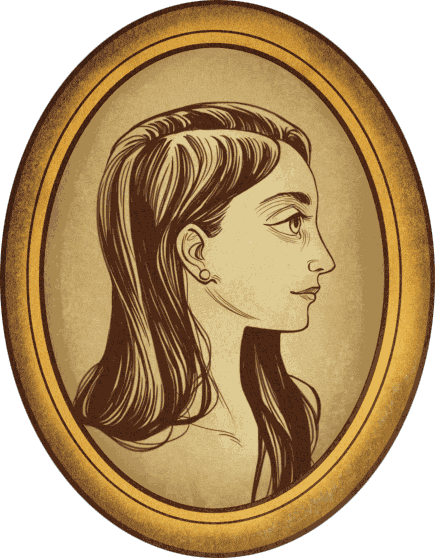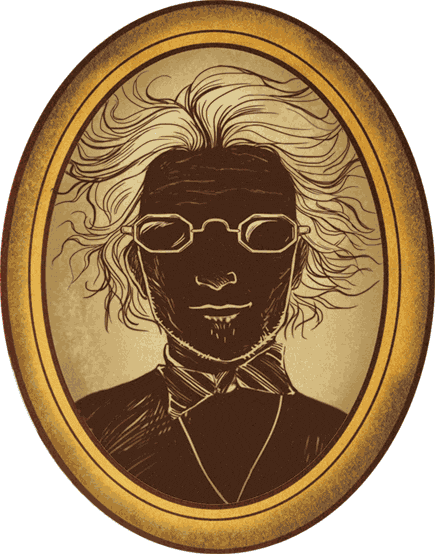
 Illustration copyright © by Benjamin Lacombe
Illustration copyright © by Benjamin Lacombe
Lauren Oliver
I was born in Queens and raised in Westchester, New York, in a small town very similar to the one depicted in Before I Fall. My parents are both literature professors, and from a very early age, my sister and I were encouraged to make up stories, draw, paint, dance around in costumes, and essentially spend much of our time living imaginatively. Our house was old and full of art and towers and towers of books, and that’s still the kind of house I like best.
I started writing as a way of extending my love of reading; when I read a book I loved, I would continue to write sequels for it (I was inadvertently a fan fic writer, before “fan fiction” was even a term!). Later on, I began working on my own stories, and keeping company with a lot of imaginary friends.
I pursued literature and philosophy at the University of Chicago, and then moved back to New York to attend NYU’s MFA program in creative writing. I simultaneously began working at Penguin Books, in a young adult division called Razorbill, and while there, I started work on Before I Fall. I left in 2009 to pursue writing full-time, and now I happily work in my pajamas every day.
I have a variety of interests apart from writing, including reading, cooking, traveling, dancing, running, and making up weird songs. Some of my favorite things are: being cozy; fires; autumn; fuzzy slippers; very high heels; great wine; dark chocolate; ketchup; pasta. Things I hate: practical shoes, liars, and bananas. I divide my time between Westport, CT, Chatham, NY, and various hotel rooms.

 Illustration copyright © by Benjamin Lacombe
Illustration copyright © by Benjamin Lacombe
H.C. Chester
The Chester family dates all the way back to the year 1620, when my great-great-great-great-grandfather, Hezekiah Chester, arrived from England on the Mayflower. Unfortunately he spent the entire journey in an acute state of seasickness and, when the ship anchored at Cape Cod, he was still so unsteady on his feet that, upon disembarking, he slipped off Plymouth Rock and drowned, leaving his widowed wife, Zenobia, and newborn son, Jeremiad.
From his earliest age, Jeremiad displayed a keen interest in studying the many varieties of mushrooms that grew in the forest surrounding his family’s cottage. By the age of twenty, he had already begun work on his definitive Guide to the Edible Mushrooms of New England, a book that almost certainly would have become a classic in its field had he lived to complete it. Tragically, he died when he made a slight misidentification of a deceptively delicious-looking toadstool.
In the ensuing centuries, the Chester family produced generation upon generation of renowned scholars and scientists, perhaps none more celebrated than my paternal grandfather, the famed ornithologist, J. Cuthbert Chester. J. Cuthbert Chester created a sensation at the annual gathering of the American Bobolink Association when he reported on his sighting of a unique aquamarine-breasted Bobolink that had landed on his front lawn the previous October and been nesting there ever since. Sadly, his landmark discovery was called into question when it was discovered that a neighbor, who was painting his house, had accidently spilled a quart of aquamarine paint in his backyard birdbath and the Bobolink had taken a dip in it.
As many young men do, my own father, Orestes Chester, chose a career path radically different from that of his eminent father, rejecting the realm of science and pursuing an advanced degree in literature. His dissertation on the neglected Restoration poet, Dudley Smythe-Wigglesworth-–author of the magnificent elegy, “”The Moste Tragickal Death of Puffins the Jester: A Ballade in Five Parts” – is widely regarded as the finest work on the subject. Even those nitpicking academics who have pointed out that it is also the only work on the subject have acknowledged the stunning originality of my father’s work.
Like most women of her generation, my mother, Ethelene, was primarily a housewife and mother. In addition to her remarkable cooking skills—even today, the memory of her legendary canned-tuna-and-fruit-cocktail casserole lingers upon my tastebuds—she possessed exceptional artistic abilities. One of her pieces, a mosaic of Leonardo da Vinci’s “Last Supper” created from individually hand-colored macaroni noodles, occupied pride of place on the wall above our living room mantel.
Like other boys, I spent many happy hours engaged in a favorite hobby: in my case, taking my mother’s discarded kitchen aprons and making them into historically accurate costumes for my pet Rottweiler, Buster. I still recall the perfect hours I spent roaming the woods and meadows around our house with Buster, dressed in his Marie Antoinette coronation gown, trotting happily at my side.
The turning point in my childhood--indeed, in my life--occurred when I was six, when during a routine visit with my parents to an antique shop my eyes fell upon a wondrous sight: a taxidermically mounted specimen of a large Peruvian fruit bat. Stuffed Peruvian fruit bats became the ruling passion of my life. Before long--through postal correspondence with the various dealers who advertise in the pages of the bi-monthly Peruvian Fruit Bat Fanciers Newsletter--I had acquired a dozen more preserved specimens of these endlessly fascinating creatures.
It was the seed of what was to grow into the H. C. Chester Relics Collection, the largest private assemblage of its kind in the entire country, if not indeed the world! Now I live happily with my best friend and companion, my dog “Trudy”, in the ancestral home in which I grew up, surrounded by all of the wondrous and strange items I have collected over the past six decades.

Interview with H.C. Chester
I was a mere lad of six or seven. My mother and father, who shared a passion for collecting Victorian tableware, took me to an antique shop they frequently patronized. While they were examining an especially fine specimen of a vintage Staffordshire coffee mug, my eyes fell upon a wondrous sight: a taxidermically mounted specimen of a large Peruvian fruit bat.
Like any normal boy, I was immediately seized with a desperate desire to own it. It was then that I was first bitten by the collecting bug. I was also bitten by several actual bugs of the species pulex irritans, more familiarly known as the common flea, a large number of which had infested the fur of said bat.
It happened in the year 1973. I was a vigorous twenty-five-year-old who, like any red-blooded, all-American youth, devoted most of my leisure time to the acquisition of rare antiquities.
Let me hasten to add that, although I possess warm feelings towards all humanity, I have never seen the necessity of interacting with actual people on a personal level. I had already withdrawn into the blissful seclusion I have enjoyed ever since, my sole companion being my dearest “pal,” my dog Trudy. Rarely, if ever, did I leave the comfortable confines of my home, a habit I maintain to this day.
As a result of my preference for remaining happily indoors, my collecting was accomplished entirely by mail. Among the individuals with whom I was in regular correspondence was a rather odd fellow who made his living as a “junk dealer.” I had purchased some rather interesting items from him: a mounted display of the life cycle of the dung beetle, for example, and an anatomically accurate, full-scale model of a dissected bullfrog.
Sometime, as I have said, in the year 1973, I received a letter from him informing me that he had come into possession of the contents of a long-shuttered dime museumBefore long, we had negotiated a “deal.” He drove the items to my home in a rental truck, and I was so thrilled to receive them that--since he had travelled several hundred miles to make his delivery--I was almost tempted to invite him into my house to have a cup of tea with me, and might have done so had it not been the hour I set aside each afternoon to play “hide and seek” with Trudy.
The dime museum, which flourished in our country from the late decades of the nineteenth century until the early years of the twentieth, was a popular showplace, offering both entertainment and instruction to the great American public. For a modest admission fee, a visitor could view a wide assortment of wonders: everything from living “freaks” (a term that, in our age of political correctness, has fallen out of favor) to amazing relics. My own collection, for example, includes what purports to be a genuine unicorn horn, as well as a feather from the winged horse Pegasus, both of which I have reason to suspect are not entirely genuine.
In any event, these establishments, appealing to the timeless human appetite for the marvelous and miraculous, drew thousands upon thousands of ordinary men, women, and children, seeking escape from the humdrum dullness of their workaday lives. Gradually, however, these palaces of wonder were replaced--or more accurately, killed off--by the cheap technological amusements of the modern world: radio, motion pictures, television.
Hmmm, a difficult question, since, if I may be permitted such an immodest statement, I own so many extraordinary items. One of my favorites was the fossilized leg-bone of a prehistoric pterodactyl. Unfortunately, Trudy recently managed to get hold of it and buried it somewhere in our backyard, where I have yet to locate it.
Let me see . . . Some years ago, I acquired, at no little cost, an ancient Arabian oil lamp, which the seller assured me was the very one used by Aladdin to conjure up his genie. I have since spent many hours rubbing it, to no avail, though, as a result of my efforts, it has attained a high sparkling polish that makes it a very handsome addition to my collection of antique lighting fixtures.
I also own the shovel with which, according to legend, the famed pirate Long John Silver buried his hoard on Treasure Island. Now that I think of it, I might be able to use it to dig up the fossilized dinosaur bone that Trudy, bless her mischievous canine heart, buried in the backyard!
Once I became owner of the remnants of the Dumfrey Dime Museum, I felt it my responsibility to do as much research as possible into this long-vanished institution. What I discovered was a story so extraordinary--so incredible--so utterly fantastic--that it almost defied belief. Indeed, if I didn’t have the actual physical proof of its reality right here in my possession, I myself might regard it as nothing more than the figment of someone’s fanciful imagination.
Few people realize that H. C. Chester possesses a quite highly developed “sense of humor,” a faculty I inherited from my late father who. Here is a joke I heard many years ago that never fails to elicit a “belly laugh” from me whenever I think of it:
“What sound does a nut make when it sneezes?”
“Cashew!”
Hahahahahahahahaha!
